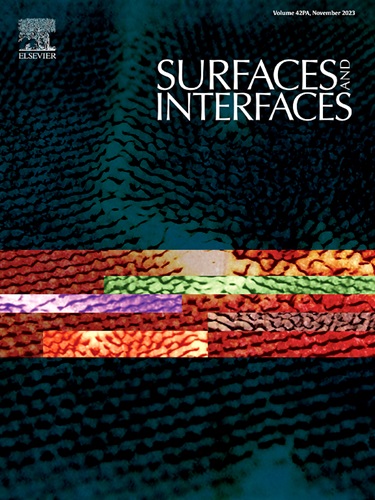Effect of exposing Se pre-implanted polycrystalline SiC to maximum electronic energy loss of 33.7 keV/nm and annealing
IF 5.7
2区 材料科学
Q2 CHEMISTRY, PHYSICAL
引用次数: 0
Abstract
In this work the effect of swift heavy ions (SHIs) (710 MeV Bi51+) irradiation and annealing on selenium (Se) pre-implanted silicon carbide (SiC) was investigated. SiC samples were implanted individually with 200 keV Se ions to a fluence of 1 × 1016 cm−2 at both room temperature (RT) and 350 °C. Following this, some pre-implanted samples were irradiated at RT with 710 MeV Bi51+ ions to a fluence of 1 × 1013 cm−2. These irradiated samples then underwent sequential annealing at temperatures ranging from 1000 to 1200 °C, in 100 °C increments, for 10 h. The samples were characterized using Raman, SEM, TEM, and RBS. Sequential annealing of the RT pre-implanted and then irradiated sample up to 1200 °C led to recrystallization of the highly defective SiC layer into strained nano-crystalline SiC with cavities, accompanied by the formation of Se precipitates. In contrast, sequential annealing of the 350 °C pre-implanted and then irradiated sample up to 1200 °C also caused recrystallization of the defective SiC layer into nano-crystalline SiC, but with minor strained regions. No loss or migration of Se was detected in either the RT or 350 °C pre-implanted samples following SHIs irradiation and annealing up to 1200 °C.

在这项工作中,研究了迅猛重离子(SHIs)(710 MeV Bi51+)辐照和退火对硒(Se)预植入碳化硅(SiC)的影响。碳化硅样品在室温(RT)和 350 °C条件下分别被植入 200 keV Se 离子,通量为 1 × 1016 cm-2。随后,在室温(RT)下用 710 MeV Bi51+ 离子以 1 × 1013 cm-2 的通量对一些预先植入的样品进行辐照。然后,这些经过辐照的样品在 1000 至 1200 °C(温度以 100 °C 为增量)的温度下连续退火 10 小时。先预埋 RT 再辐照 1200 ℃ 的连续退火会导致高度缺陷的碳化硅层再结晶成带有空穴的应变纳米晶碳化硅,同时形成硒沉淀。与此相反,将 350 ℃ 预植入然后辐照的样品依次退火至 1200 ℃,也会导致有缺陷的碳化硅层再结晶为纳米晶碳化硅,但会出现小的应变区域。经过 SHIs 照射并退火至 1200 °C,在 RT 或 350 °C预植入样品中均未检测到硒的损失或迁移。
本文章由计算机程序翻译,如有差异,请以英文原文为准。
求助全文
约1分钟内获得全文
求助全文
来源期刊

Surfaces and Interfaces
Chemistry-General Chemistry
CiteScore
8.50
自引率
6.50%
发文量
753
审稿时长
35 days
期刊介绍:
The aim of the journal is to provide a respectful outlet for ''sound science'' papers in all research areas on surfaces and interfaces. We define sound science papers as papers that describe new and well-executed research, but that do not necessarily provide brand new insights or are merely a description of research results.
Surfaces and Interfaces publishes research papers in all fields of surface science which may not always find the right home on first submission to our Elsevier sister journals (Applied Surface, Surface and Coatings Technology, Thin Solid Films)
 求助内容:
求助内容: 应助结果提醒方式:
应助结果提醒方式:


